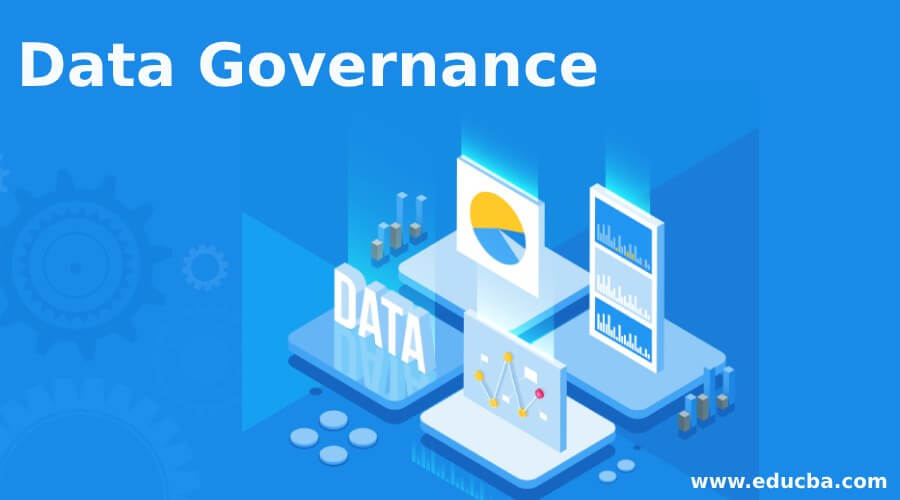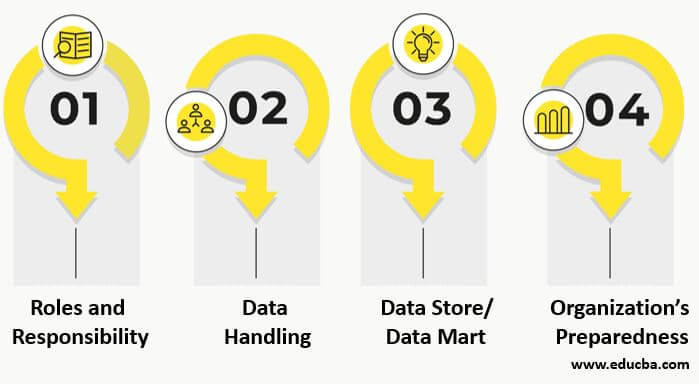Introduction to Data Governance
Data governance can be defined as a compilation of various activities involved for utilizing the data for facilitating the organization towards its purpose. These activities include the organization’s practices, dedicated roles for every activity, regulatory policies & terms to be followed, etc. When these activities are kept in – check, the data Governance is said to be exceptional by attaining maximum efficiency for data processing. This process helps in commencing the data management techniques and related tasks so as to guarantee the performance and data security for the data being handled transversely through the organization, which can be applied at any time and in any situation.
Components of Data Governance
Data Governance Components are picked based on a few routine questions, like Who, Why, What, When, How, etc.
Below are the categories with respect to the said questions:
WHO – People in the Organization
- User Group Charter
- Escalation Hierarchy
- Role Structure
- Data Keepers
- Decision Making Professionals
WHY – Target
- Achieve the set Goals
- Mission & Vision
WHAT – Centre of Attention
- Factors that Quantify
- Financial Support
- Regulatory Plan
- Data Management Methods
WHEN – Activities
- Data Analysis
- Process Plan
- Implementation of Plan
- Data Management Process
- Record the Process Progress
When these components work along with one another, there comes efficient Data Governance for the given organization. Under each of these components, there can be a number of people, roles, and actions carried out. Apart from this, Data Governance can be achieved technologically with the help of the Metadata Repository, Data Profiling Tools, Data Cleansing Tools, Data Mining Tools, Data Management activities, etc.
A mixture of processes performed in Data Governance is sticking to the organization’s policies, process monitoring, data cleansing, data profiling, data extraction, data analysis, data processing, etc. These smaller processes make a bigger impact on the organization’s Data Governance rates, as each of the activities is interdependent in most of the cases.
Data Governance Process
A well-controlled Data Governance approach is an essential constituent for an institute’s performance, where the data science technologies are put in use. It aids in taking the multiple Data Governance components in –line, which simply means all the minor activities that contribute to any and all the Data Governance components. The people/ roles involved in this process, like Business professionals, who make the important decisions, are responsible for emphasizing the particulars on the data to be handled under data governance.
The Strategic ability of Business professionals is going to play a key role in the implementation of Data Governance in an organization. The Data Governance method can be plainly explained as an information administration process, which has greater significance on an organization’s efficiency.
Data Governance Challenges
Constructing and applying a Data Governance flow in an institution is an intimidating and overpowering task. In addition to a proper management team, Data Governance requires a completely workable plan and the ability to follow the plan to the point, without any deviations. A few of the common problems observed in employing the Data Governance technique in an organization are:
1. Roles and Responsibility
It is hard to place the respective people’s inappropriate roles for handling the designated responsibilities in the data sector in the said organization. Structuring the data governance procedure involves people handling, placing the respective person in a suitable role, access level to the data, every person’s accountability, etc. On the highest level is the Chief Data Officer of the organization, which has become a regular practice in this technologically evolving world of Data.
2. Data Handling
A Major hiccup observed in many cases of Data Governance application is that the data is gathered from multiple data sources, and not all the data sources are going to be clean and processed. It is important to gather junk-free data in order to maintain the efficiency of the Data Governance method produced by the organization.
3. Data Store/ Data Mart
Another vast obstacle for Data Governance is the compartmentalizing ability, which is not a given in many databases. In most cases, the data permissions are administered by the database admin or the owner, where access permissions are provided based on the roles of the personnel working on the data. When the permissions are not set as required, then it has to be verified and updated as and when the requirement arises. This again involves the team members and their ability to collaborate with the other team members or teams.
4. Organization’s Preparedness
When organizations pick up the benefits of Data Governance and decide to implement the same in their own organization, it is highly likely that they look only at the external factors. It is equally important to look at the internal practices of the organization that are being practiced in the current situation. The work pattern should be modified in a way to accommodate the upcoming changes along with the Data Governance execution. While the Data Governance planning is in progress, the existing tradition of the institute should be rechecked and keep the platforms open to place the Data Governance production in place.
Advantages
Data governance facilitates organizations to handle their own data, and it is going to be an advantageous technique for the below reasons.
- Taking up the Data Governance method into an organization can improvise the company’s Data Management ability while holding the quality and value of the in–house data.
- Data grouping from different areas and sectors can help all future processes.
- Imposing people’s positions and responsibilities in data administration.
- Allowing peripheral data contribution assignments.
- Sustaining rigid consistency agreements.
- Modeling the data regulation and consumption of the data operated in Data Governance.
- Helps in trimming down the disorganized data and managing the costs for data management.
Conclusion
To sum up, Data governance assists in making definite about the places of every role and task that is required for carrying out of Data Governance in a Venture. When designing the Data Governance configuration by embracing the deliberations, the company’s imprudence is fixed once for all in terms of administration and management of data.
Recommended Articles
This is a guide to Data Governance. Here we discuss the introduction and data governance components along with the process and challenges. You may also have a look at the following articles to learn more –



